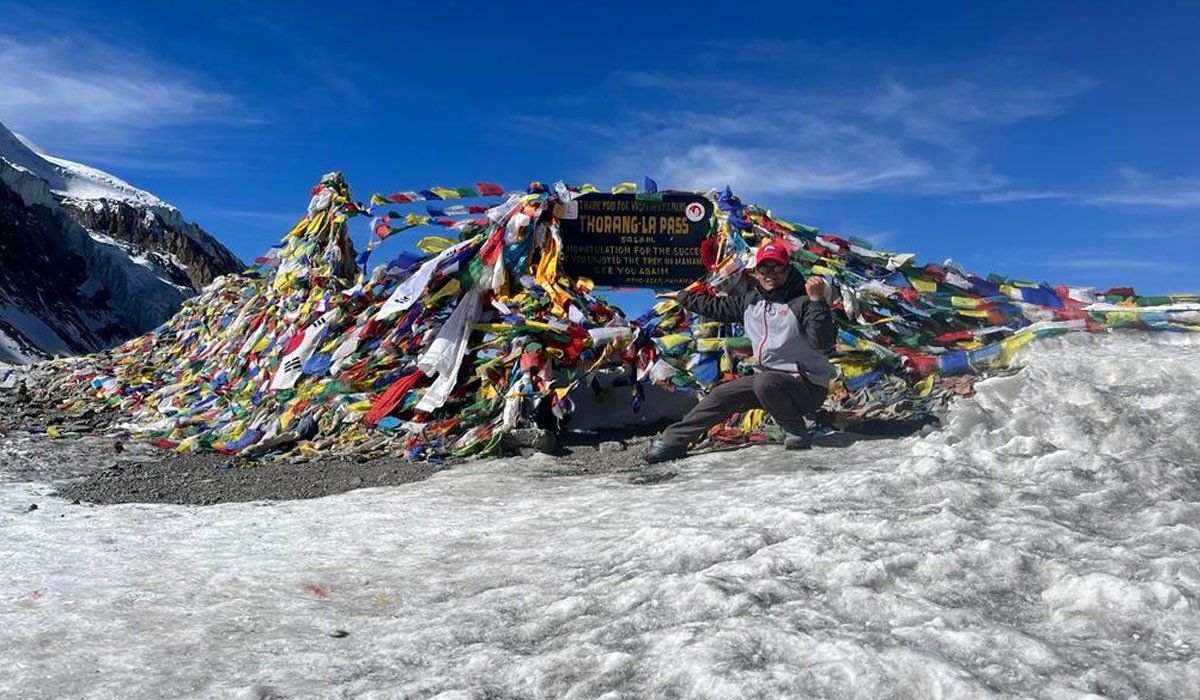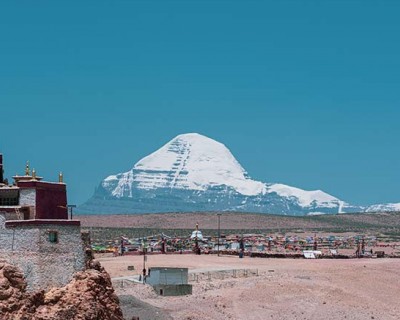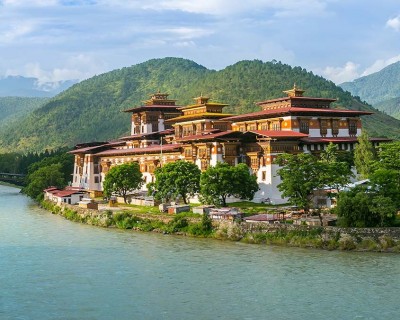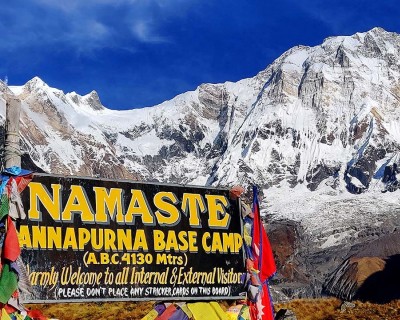Annapurna Circuit Trek in March - Overall Trek Overview
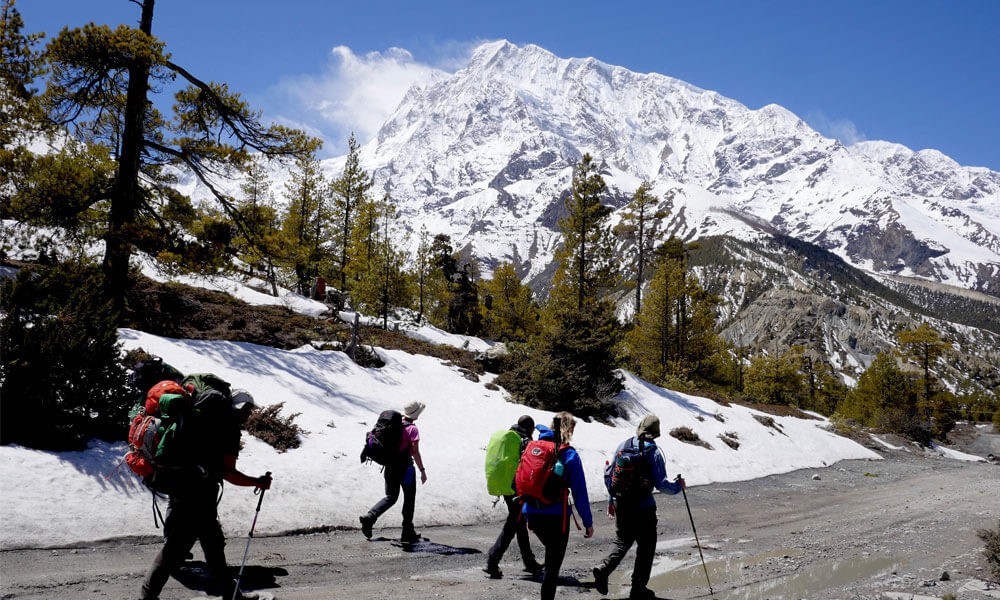
For an incredible trekking experience on the second most popular trekking route in the Himalayas during the starting month of the spring season, you can choose several options. The standard packages of the Annapurna Circuit Trek have a duration of 12-22 days, and the itinerary plans of the package may differ depending on the route, acclimatization days, and side detours in the region.
The general trek of the Annapurna circuit in Nepal starts with a delightful drive from Kathmandu to Ngadi [930 meters/ 3,051 feet]. From here, you will commence your trekking adventure and move along the stop points like Chamje [1,410 meters/ 4,625 feet], Bagarchhap [2,160 meters/ 7,086 feet], and Chame [2,710 meters/ 8,891 feet].
Moving further ahead from Chame, you will traverse to the high elevation point of this mainstream trekking route like Pisang [3,300 meters/ 10,826 feet], Manang [3,540 meters/ 11,614 feet], Yak Kharka [4,120 meters/ 13,517 feet], Thorung Phedi [4,560 meters/ 14,960 feet], and the highest elevation point of this trekking adventure Thorung La Pass [5,416 meters/ 17,769 feet].
Then, completing the circumnavigating adventure towering Annapurna, you will commence your descending journey from Muktinath [3,820 meters/ 12,532 feet] to Tatopani [1,190 meters/ 3,904 feet] and do some side exploration of Ghorepani [2,750 meters/ 9,022 feet] and the most popular vantage point of Annapurna region, Poonhill [3,210 meters/ 10,531 feet]. This vantage point offers incredible panoramic views of Annapurna, Dhaulagiri, Machhpuchare, Dhampus, and Hiunchuli.
During the last part of this classical trekking adventure in the Himalayas, you will trek down to Ulleri [2,050 meters/ 6,725 feet] and drive down to Pokhara [820 meters/ 2,690 feet]. Then, you will conclude the adventure with a scenic drive back to Kathmandu [1,400 meters/ 4,593 feet] from Pokhara.
Why Annapurna Circuit Trek in March?
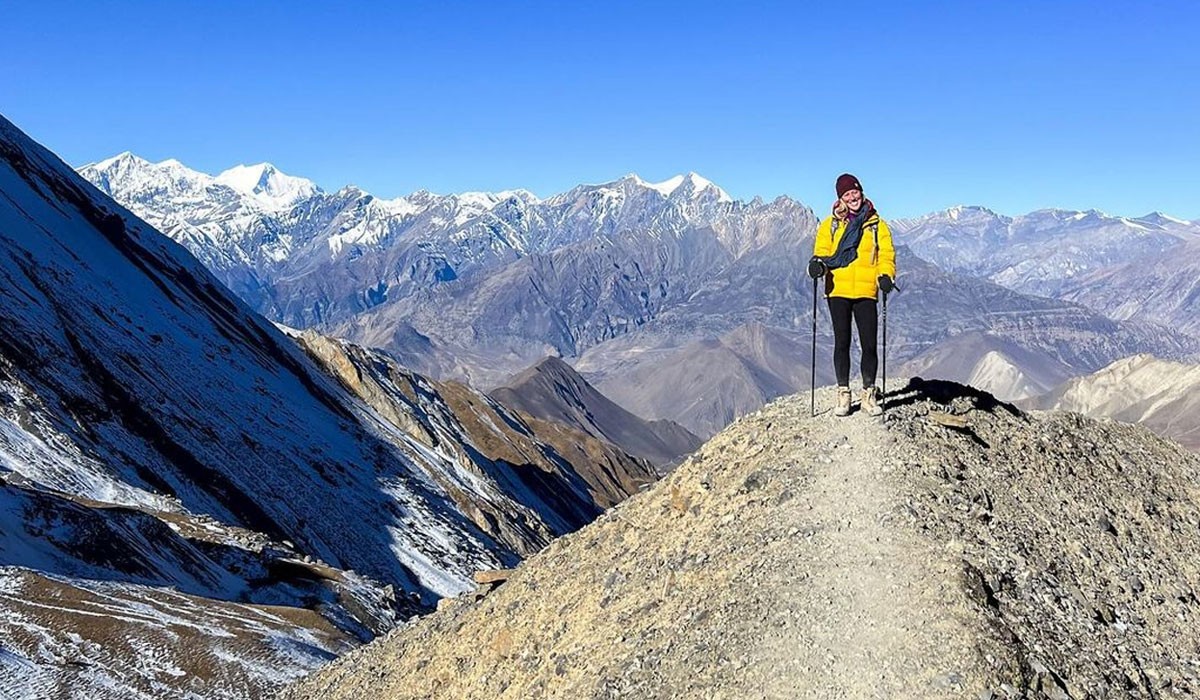
Perfect Climate
As March month is right after the end of the winter season in February, the temperature of the high-altitude regions is still somewhat chill and cool. You will be accompanied by fresh, chill breezes during the early morning and evening, which makes your trekking adventure remarkably delightful.
The temperature of the Annapurna region can reach its maximum of about 30°C at the lower regions; however, the early morning and night temperatures at the alpine altitude can drop upto -9°C. Weather in the region is also particularly stable, and the days are usually clear and sunny. So, doing the Annapurna Circuit Trek in March will feel like you are reaping the climatic benefits of the perfect autumn season, but enjoying the natural allurements of the spring season.
Breathtaking Scenery
It is no secret that the blooming season of spring brings the lush and vibrant landscapes with it. So, while doing the Annapurna Circuit trek in March, you can expect the most stunning and vibrant landscapes out of all seasons. The lower trekking trails of this mainstream trekking route are completely covered by dotted rhododendrons and other colorful wildflowers.
To put it simply, the natural allurements of the region are at their pinnacle; you won’t see anything as magical as the colorful landscapes with diverse colors brimming with life. Furthermore, due to the melting snow, the cascading rivers, streams, and waterfalls nourished by the Himalayas add further magic to your trekking adventure.
Less Crowd
Compared to the peak seasons, both spring and autumn, the season favored by nature, in particular, receives more trekkers than the fall season. This is mainly due to the pleasant climatic conditions; spring is much warmer than the autumn season, even at high altitudes. So, trekkers prefer this season to comfortably explore the alpine altitudes without worrying about the cold.
However, there is a catch while doing the Annapurna Circuit Trek in March, as this month is right after the winter season, i.e., February; most trekkers wait till the weather starts getting warmer. It's not particularly cold in this month, but bits of the winter season do linger around, adding freshness to the adventure. So, if you want to skip the crowded route of the peak season without missing the full bloom of spring, March is the perfect month to schedule this adventure.
Phenomenal Mountain Views
Due to the low precipitation rate, the days of March month are clear and sunny, which provides you the opportunity to catch the perfect glimpse of the Himalayan massifs. This popular trekking route in the Himalayas is known for the mesmerizing views of the Annapurna Massifs, Machhapuchare, Dhaulagiri, Gangapurna, Nilgiri, Tukuche, Manaslu, Tilicho and other surrounding peaks.
So, while doing the Annapurna Circuit Trek in March, you will be able to immerse in the incredible up-close beauty of these towering peaks. Enjoying the incredible mountain views amidst pristine landscapes covered with slowly melting snow will create a perfect window frame for you to experience the cycle of nature before the bloom of the spring takes over.
Festive Vibe
Nepal celebrates some of the most remarkable and fascinating festivals throughout the year. So, during your Annapurna Circuit trek in March also, you will be able to experience some of the exciting festivals of the spring season. Nepal follows the lunar calendar, Bikram Sambat, so the festivals often hover between two particular months. However, the month of March invites unique festivals in the country like Maha Shivaratri, Chaitra Dashain, Holi ( the festivals of color), Ram Navami, and Gyalpo Lhosar.
Although this month doesn’t celebrate grand festivals like Dashain and Tihar, you will still get the opportunity to experience some of the unique and delightful festivals during your trek. You will get the opportunity to add cultural and traditional prospects to your exciting Himalayan adventure and maybe even participate with the loving and humble natives.
Photography Opportunities
Spring season is the peak season of nature, but it doesn't mean that only the landscape of the region is incredibly beautiful. The Himalayan wildlife and birdlife are also most active during this season. So, during your Annapurna Circuit Trek, you will have a high chance of catching the perfect shot of the endangered species of the Annapurna Conservation Area (est 1985).
You will also have the opportunity to capture spectacular photographs of the Himalayan vistas with different shades of the landscapes in the foreground and clear blue sky in the background, making your snapshot seem like a portrait straight out of imagination.
What Are Challenges of Doing Annapurna Circuit in March?
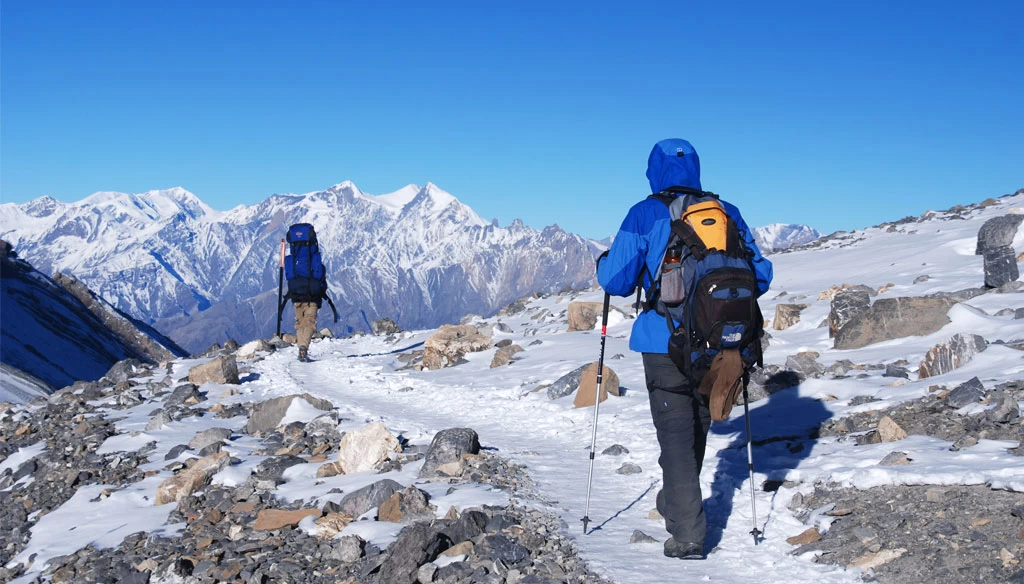
Annapurna Circuit is a remarkable exploration of the Himalayas; compared to other high-altitude remote explorations, this trek is considered to be slightly easier. Although this exploration has been graded at a moderately difficult level, it still isn’t as demanding as the other high altitude adventure. The highest point of this circuit trek, Thorung La Pass [5,416 meters/ 17,769 feet], is a major factor behind why this trekking adventure is in the moderate level class.
Thanks to the availability of road transport and low elevation points of this trek, even a complete beginner to high altitude trekking can easily complete the Annapurna Circuit Trek. Still, you need to prepare to overcome some of the major difficulty factors like:
Altitude Sickness: Even if this trekking adventure takes you to high elevation points like other high passes and remote exploration, you will still gain a significant altitude in this exploration. The risk of altitude sickness starts over the elevation of 2,500 meters, and you will spend a significant amount of time over this point at Manang, Yak Kharka, Thorung Phedi, and Thorung La Pass. So, you will still need to pay attention to any symptoms of altitude sickness and acclimatize properly.
Trekking Hour: Duuring your Annapurna Circuit Trek in March, your trek on the circumnavigating route that stretches about 160 km to 230 km (100 miles to 145 miles). Thus, you will need to cover a significant walking distance during the trekking days, approximately 6-7 hours on average. Walking for a long period of hours can be physically exhausting if you are not well prepared.
Acclimatization:Acclimatization is the most crucial factor of any high-altitude adventure; you need to adapt properly to the new altitude as you move forward with your inclining route. If you don’t acclimatize effectively, then you will put yourself at risk of altitude sickness and other sickness as your body doesn’t get enough time to rest. So, for a comfortable and safe exploration, you need to select the right package with enough acclimatization days.
Remoteness: Compared to other remote trekking adventures in the Himalayas, the Annapurna circuit is slightly more developed. However, it is still a high-altitude adventure that explores the secluded part of the Himalayan region. So, you shouldn’t be expecting top-tier services and amenities throughout the trekking route.
Read this next:
Preparation for Trek
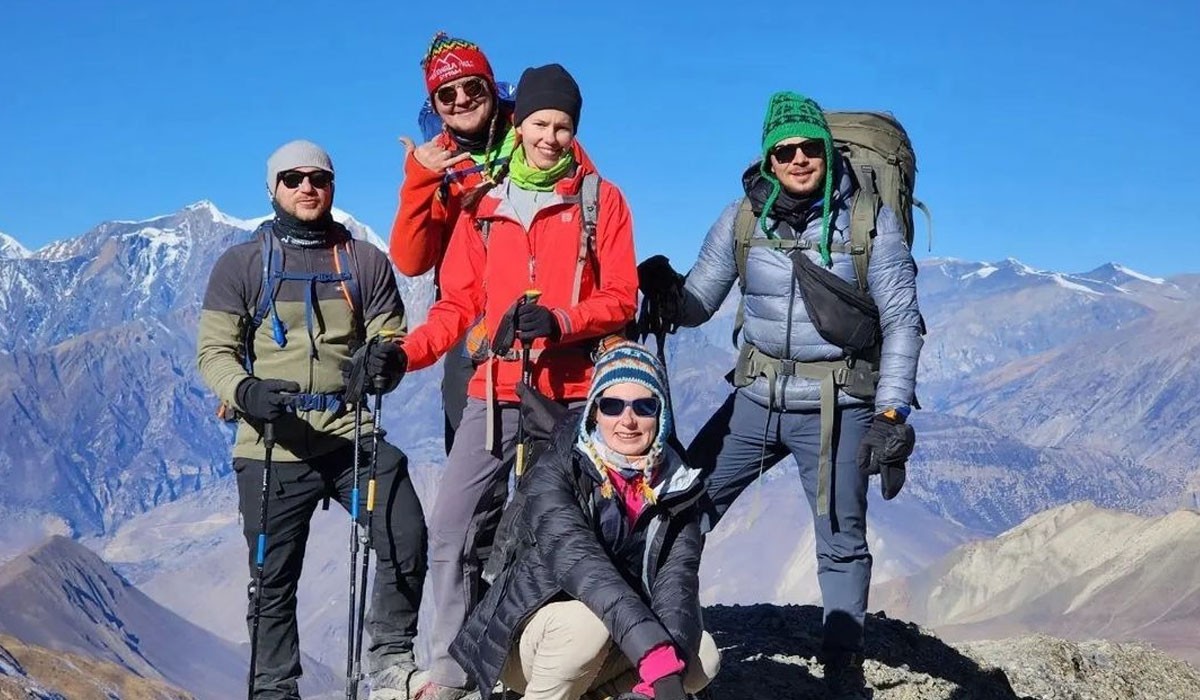
If you are willing to put some hours into your preparation part before the trek, you will be able to have a delightful experience. Even if you are a beginner, you don’t need to train for months; just 4-6 weeks of preparation will be sufficient to do the Annapurna Circuit Trek in March.
You can adjust the training period according to your needs as well, if you are in top shape and workout regularly, then just a short period of training might be sufficient for the trek. However, if you are not that much into exercising, then, you gonna have to be determined to put some extra hours into your preparation.
The most effective way to determine the training plans for this adventure is to consult with a trainer or your guide. You can also do some hikes around the nearby steep landscapes carrying your backpack, so you will have a proper understanding of what you can expect during the actual trek. This way, you will be able to create an efficient training plan after analyzing your weak aspects.
Training recommendation:
For Strength: Plank, push up, pull up, deadlift, squat, lunge, overhead press, dips, hollow hold, bench press, leg press, bicep curl etc
For Stamina: Swimming, dancing, jogging, cycling, jumping rope, burpees, stair climbing etc
Accommodation and Food
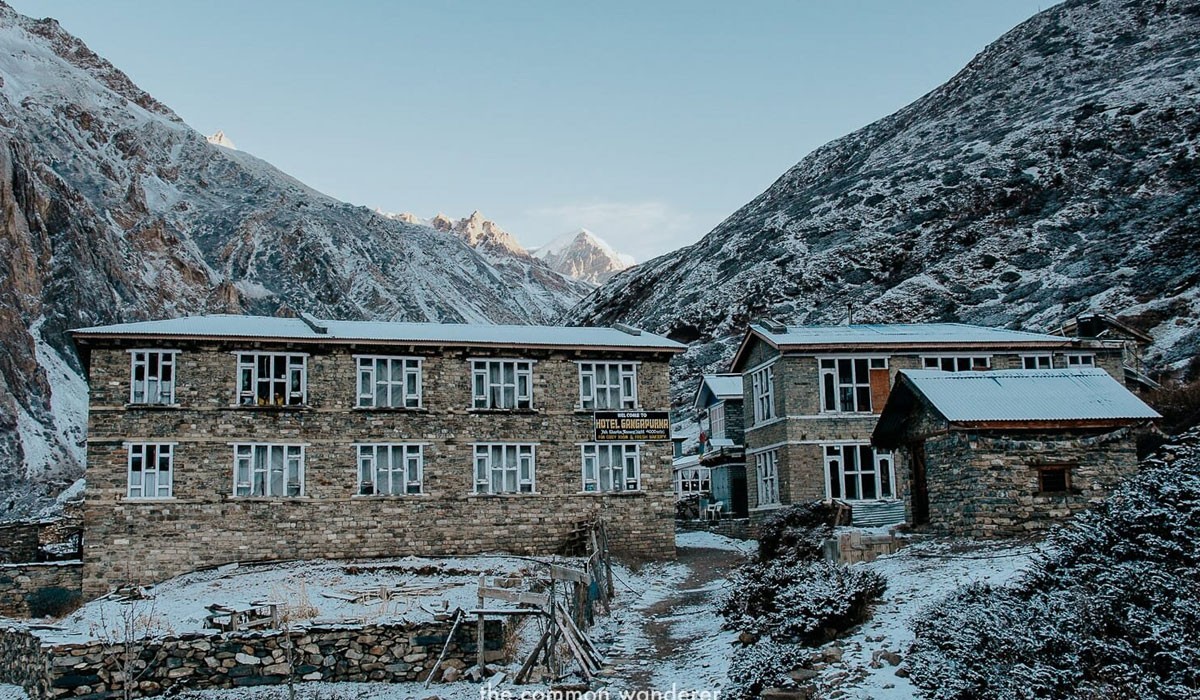
During your Annapurna Circuit Trek, you will spend 12 nights at the teahouses/lodges along the trekking trail and 1 night at the tourist hub, Pokhara. Some of the itinerary plans will also include staying 3 nights at a star hotel in Kathmandu if the departure part is included.
So, during your stay at a star hotel in Kathmandu and Pokhara, you can expect all the modern and luxurious services and amenities. You can also book the luxurious trekking packages for the Annapurna Circuit Nepal if you want to add some premium feel to the exploration.
However, in your standard package, you will stay in well-established teahouses/lodges with comfortable and warm rooms. There are two to three adjacent beds in a single room, and bathrooms are either attached or outside on the same floor. Overall, you will have a comfortable rest along the well-equipped teahouses/lodges as you move along with your trekking route.
Food
Doing the Annapurna Circuit Trek in March introduces you to tasty and tongue-lingering seasonal cuisines of the spring season. One of the best things about doing the teahouse trekking in Nepal is that most of the food you eat at the teahouses/restaurants is prepared using homegrown local ingredients.
Not only are they super delicious but also healthy and nutritious, perfect to fuel your long hours of trekking adventures during each day. Generally, the regional dishes that represent the diverse ethnic communities of this beautiful Himalayan nation are the top choices among the trekkers at the teahouses.
However, it doesn’t mean that dishes along your trekking route are limited to that. You will also get the opportunity to explore other Asian culture-influenced dishes (especially Indian and Tibetan) as well as some of the popular star continental dishes, but of course, with unique Nepali touches.
Water
During your trek, you should at least drink 3-4 liters of water during your trek, as dehydration is one of the leading causes of Acute Mountain Sickness (AMS). We do not recommend you buy plastic water bottles along the route to avoid the thrashing problem, and it is also quite expensive.
Instead, your guide will fill your bottles at water stations, you can use filter bottles and purification solutions or tablets to make your water drinkable. The water in the mountain is pure and clean, still, it will be better if you stay cautious and take proper measures. You can also buy and store boiled and filtered water at the teahouses, which can cost US$ 1 to US$ 2 per pot.
Menu for Breakfast: Tea, coffee, juice, eggs, bread, toast, jam, butter, honey, Tibetan bread, muesli, oats, cornflakes, chapati, porridge, pancake, etc.
Menu for Lunch and Dinner: Traditional dal bhat & tarkari, noodles/spaghetti, momo, chowmein, macrons, pizza, pasta, fries, sandwich, pudding, dhindo, gundruk, thukpa, rildok, shya phale, etc
Trek Safety
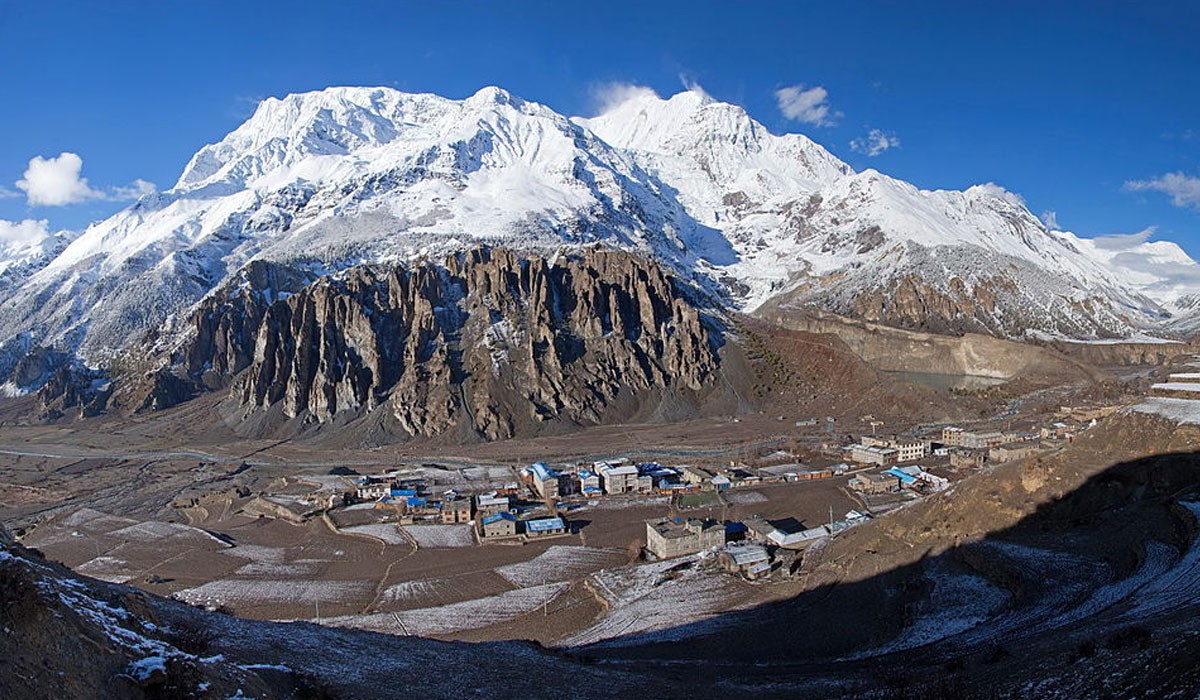
The safety and comfort of our guests are our top priority; your trekking adventures are led by government-licensed guides who have numerous years of operation experience in the region. Our guides are fluent in English and are also well-trained for high altitude response by the Kathmandu Environmental Education Project (KEEP).
Our guides will monitor your physical and mental health throughout the trek. They will also check the oxygen saturation level of your body with the help of an oximeter during each day of the adventure to see how well you are adapting to the new altitudes. In case of any difficulties or sickness , your guide will relay the information to our head office in Kathmandu (available 24/7).
Your guide will make the call if you should be transferred to a nearby health facility or evacuated to Kathmandu with the help of a helicopter. We also make arrangements for supplementary oxygen and a Portable Altitude Chamber (PAC) if necessary.
